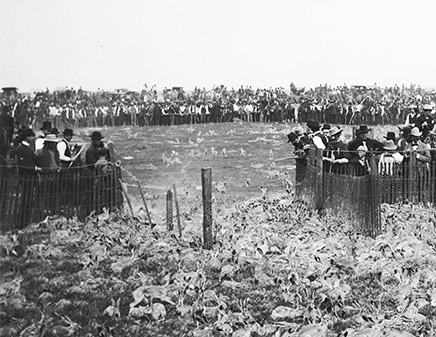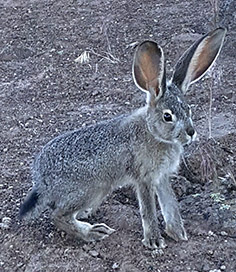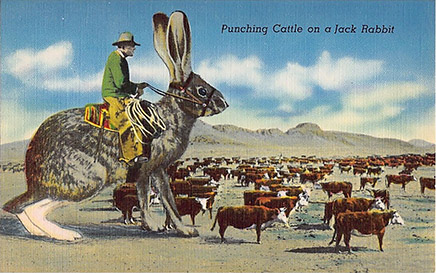CONTINUED FROM THE PRINT EDITION:
Good time had by all at bunny-massacre parties
The little hoppers are a pretty common sight in the sagebrush country today, and campers find them surprisingly friendly in places like Hart Mountain and Goose Lake. There are even times when, driving toward Lakeview or Burns, it’s impossible to miss the frequent bloodstains on the road where jackrabbits have darted out in front of cars. Perhaps you’ve even hit one or two; most of us have. They tend to wait until the last possible second before darting out. You don’t have to go too far back into the past, though, to find jackrabbit populations in staggering levels. The boom in the population of the little rodents came as a result of the last gasp of homesteading, between about 1900 and 1925, in the high-desert area of central and eastern Oregon. For time out of mind the jacks lived amid the bunchgrass and sagebrush, grubbing out what food they could from an environment that had evolved to keep them in check. There wasn’t a lot for a hungry jackrabbit to eat in a typical patch of bunchgrass, so there wasn’t much in the way of encouragement for population growth. That changed when homesteaders started staking out land claims and planting delicious crops on them. Thousands of acres of bunchgrass, already grazed down to nubs by wandering sheep and cattle, got plowed under and wheat and alfalfa planted. Hundreds of families started little kitchen gardens, carefully watered and nurtured, outside of newly built homesteaders’ shacks. And hundreds of tender young saplings, clothed in the most delicious (to a jackrabbit) tree bark, were planted to shade homesteads. So the jackrabbits moved in, and for a time they must have felt they’d won the lottery — especially as there had been a bounty on coyotes for a while, so the jackrabbits’ natural predators were in shorter supply. So, of course, their population exploded. Jacks reach breeding age at seven months, so it didn’t take long before they constituted a full-blown infestation, and homesteaders were forced to resort to increasingly desperate measures. A platoon of jackrabbits could clean out a kitchen garden overnight, chewing all the plants down to the soil line and sometimes below it. Few plants could recover from this kind of abuse. Anyone who has ever lost a garden to a marauding doe and fawns can tell you what the experience of that kind of loss does to one’s attitude toward cute, fuzzy wildlife — especially for folks who are counting on the garden to get their families through the winter. “If a man had a little water for irrigation, and seeded alfalfa, the jacks had a ball,” Russ Jackman wrote, in The Oregon Desert. “They ate in it all summer, and when winter came they would dig out the crowns and eat them to three or four inches below the ground. The alfalfa didn’t enjoy this, and entire fields would die.” The homesteaders’ answer to this challenge was to start coming together for rabbit drives. They would schedule them the way they did with barn raisings; every homesteader family for miles around would come to the spread of the homesteader who was hosting the drive. Taking advantage of any terrain features that might be handy, they would set up a pen with close mesh on three sides and, forming a crescent of people, beat the bushes and shout and drive the jackrabbits before them into the pen. Then they would kill the jackrabbits, clean up, and enjoy a fun family social event for the rest of the day, with a generous picnic supper and maybe even a dance if there was a nearby barn big enough.
|

Feeling good about it was fine and all, but as far as actually solving the problem, the rabbit drives weren’t very effective. So the next thing the Eastern Oregon counties tried was bounties — a strategy that had worked pretty well with coyotes. In Harney County, they put a five-cent bounty on every rabbit pelt in 1915. The result of this was an enormous drain on the county treasury. Just over a million jackrabbit pelts were redeemed that year. The court hastily ended the bounty. The problem was, the bounty was being paid mostly to homesteaders, for the benefit of the homesteaders, and very few of the homesteaders paid taxes. Once they perfected their claims and received a government patent to their land, they’d tuck it away someplace safe rather than recording it with the county. When the time came to sell the land, or if a dispute arose, they’d have to record it; but until then, there was no reason to. And until the claim was recorded, as far as the county was concerned, it was still government land, and not subject to taxation. So the bounty basically involved taking the big stock operators’ tax money and using it to prop up non-tax-paying homesteaders. The homesteaders loved it — for many of them it was their only source of cash income — and it helped solve their jackrabbit problem, which was very serious for them. But the rabbit problem wasn’t nearly as serious for the stockmen who were footing the bill. The stockmen were happy to pay for coyote bounties, to reduce the chances of a coyote moving in and eating their lambs and calves; but they weren’t nearly as enthusiastic about ponying up for the benefit of tax-dodging homesteaders whom they suspected of occasionally poaching a cow or sheep for their tables anyway. And so the program ended and the homesteaders went back to doing rabbit drives.
THE RABBIT DRIVES didn’t have as much of an impact on rabbit populations as you might think they would, but they did something. Between that and liberal use of chicken wire to protect vulnerable crops and saplings, the homesteaders managed to get by. Later on, after the mid-1920s, the Oregon State University Extension Service started helping farmers effectively control the rabbits with poison bait stations — a mixture of strychnine and alfalfa — and this proved so much more effective than the rabbit drives that the drives just faded out. Today, rabbit populations are commonly controlled, where necessary, with poison bait — along with populations of other pest animals that compete with them for food, like mice and ground squirrels. And jackrabbits, for the most part, are back to being mostly seen as charming little characters in the dramatis personae of high-desert wildlife. It's interesting to contemplate that not so many years ago, the highlight of many Oregonians’ social calendar involved attending or throwing giant rabbit-massacring parties.
|



